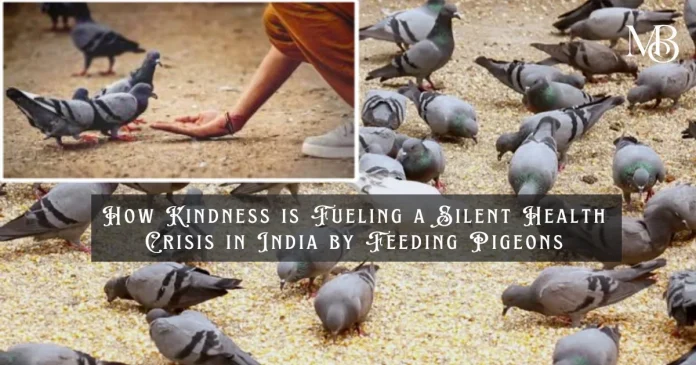Health Crisis in India by Feeding Pigeons: Pigeons are everywhere in Indian cities. From public squares to balconies, these birds have found a comfortable home in urban spaces. Many people enjoy feeding pigeons, believing it to be an act of kindness or a way to earn good karma. But beneath this seemingly innocent gesture lies a growing health and environmental crisis that few talk about.
Why Are Pigeons a Problem?
Feeding pigeons may appear harmless, but it creates an imbalance in nature. Pigeons breed rapidly when food is abundant. This leads to overpopulation, which can cause several issues:
- Health Risks: Pigeons are known carriers of diseases that can affect humans.
- Environmental Damage: Their droppings corrode buildings and public spaces.
- Impact on Native Birds: Pigeons dominate resources, pushing away other bird species.
Read more: Feeding Pigeons Crisis
Health Crisis in India by Feeding Pigeons
Health Crisis in India by Feeding Pigeons. Pigeons are not just a nuisance; they are a health hazard. Here are some diseases that pigeons can spread:
| Disease | How it Spreads | Symptoms |
| Histoplasmosis | Inhalation of fungal spore in droppings | Fever, fatigue, respiratory issues |
| Cryptococcosis | Contact with droppings | Skin lesions, lung infections |
| Psittacosis (Parrot Fever) | Inhalation of infected droppings | Fever, chills, muscle aches |
| Pigeon Fancier’s Lung | Long-term exposure to feather/dust | Shortness of breath, coughing |
Pigeon droppings can dry up and turn into fine dust, which when inhaled, can cause respiratory issues. People with weaker immune systems are at greater risk.
How Pigeons Damage the Environment?
Pigeon droppings are acidic and corrosive. Over time, this can cause significant damage to buildings, monuments, and vehicles. Historical sites in India, like the Taj Mahal, face continuous challenges in preserving their beauty due to pigeon droppings.
Moreover, leftover food meant for pigeons attracts rats and insects, increasing the chances of pest infestations.
Why Do People Feed Pigeons?
- Cultural Beliefs: In India, feeding animals, including pigeons, is seen as a religious or charitable act.
- Lack of Awareness: Many people are unaware of the health risks associated with pigeon overpopulation.
- A Simple Pleasure: Feeding pigeons can be relaxing and enjoyable for many.
However, this habit, when left unchecked, can lead to a cycle of overbreeding and disease spread.
The Pigeon Boom: By the Numbers
- A single pair of pigeons can produce up to 12 offspring per year.
- A flock of 100 pigeons can generate nearly 1 ton of droppings annually.
- In some Indian cities, pigeon populations have increased by over 150% in the last decade.
Here is a chart showing the growth in pigeon populations in urban areas over the last five years:
What Can Be Done to Control the Pigeon Population?
- Public Awareness Campaigns Educate people about the dangers of feeding pigeons. Posters, social media campaigns, and local community meetings can spread the word.
- Ban Public Feeding Several cities around the world have already implemented bans on feeding pigeons in public places. Indian cities could follow this example.
- Modify Urban Spaces
- Install bird spikes on ledges and rooftops.
- Use nets to block pigeon access to balconies.
- Clean up food waste regularly to prevent attraction.
- Provide Designated Bird Feeding Areas Local governments can create designated bird-feeding zones away from residential and historical areas.
A Case Study: Mumbai’s Pigeon Problem
Mumbai has one of the largest pigeon populations in India. In certain areas like Marine Drive and CST, pigeons gather in huge numbers daily. This has led to increased respiratory illnesses among local residents.
In 2023, Mumbai’s civic body initiated a “Pigeon-Free Zone” project by installing nets and banning pigeon feeding in crowded areas. Reports show a 20% decrease in pigeon population in just one year.
Simple Actions You Can Take to Prevent Health Crisis in India by Feeding Pigeons
- Stop Feeding Pigeons at Home: If you enjoy feeding birds, opt for sparrows or other native species.
- Seal Openings: Block open spaces in balconies and rooftops where pigeons might nest.
- Clean Regularly: Ensure pigeon droppings are cleaned safely to avoid inhalation.
Final Thoughts on Health Crisis in India by Feeding Pigeons
Feeding pigeons might feel like a compassionate act, but it carries hidden dangers that threaten public health and the environment. By understanding the risks and taking preventive actions, we can create healthier urban spaces for everyone to prevent the Health Crisis in India by Feeding Pigeons.
You might also like: 15 Types of Meditation for Mind, Body, and Soul
It’s time to rethink our relationship with pigeons due to the Health Crisis in India by Feeding Pigeons. Let’s stop feeding and start protecting our cities and health. Follow our Leisure page for more such insights.


